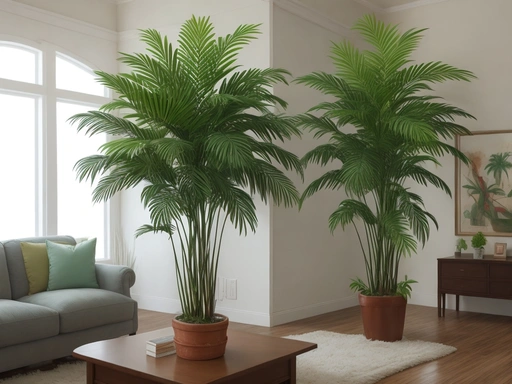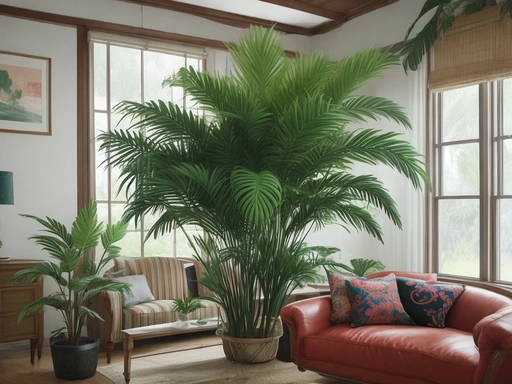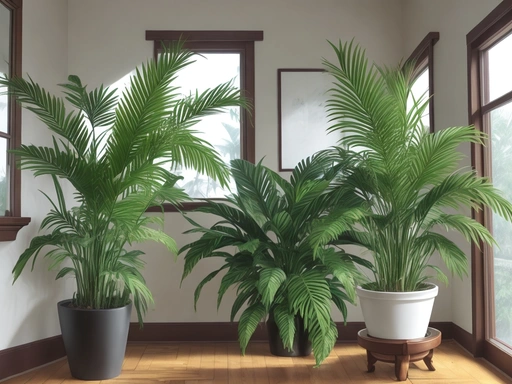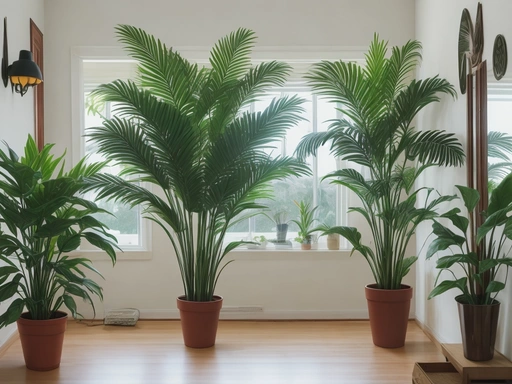Parlor Palm And DIY Plant Care Solutions for Thriving Indoor Gardens!
Key Takeaways:
- Parlor palms are low-maintenance indoor plants that can thrive in various light conditions.
- When caring for a parlor palm, maintain moderate water and humidity levels, and avoid overwatering.
- DIY plant care solutions like misting, using pebble trays, and regular dusting can help keep your parlor palm healthy.
- Regularly inspecting for pests and providing adequate drainage are essential for successful parlor palm care.
Are you tired of having plants that require constant attention and care?
Then the parlor palm might just be the perfect indoor plant for you.
With its beautiful foliage and low-maintenance nature, the parlor palm is a great addition to any home.
In this article, I’ll be sharing some DIY solutions for parlor palm care, including tips for lighting, watering, humidity control, and fertilizing.
I’ll also address common issues like yellow leaves, brown tips, and pests.
So, if you’re ready to add some greenery to your space without the hassle, keep reading!
| Topic | Parlor Palm | DIY Plant Care Solutions |
| Type | Houseplant | N/A |
| Scientific Name | Chamaedorea elegans | N/A |
| Watering | Once a week | Water as needed, based on plant requirements |
| Light | Indirect sunlight | Varies depending on the plant type |
| Size | Up to 4 feet tall | N/A |
| Care Level | Easy | Varies depending on the plant type |
| Benefits | – Air purification – Adds greenery to indoor spaces – Low maintenance | N/A |
| Drawbacks | – Toxic to pets if ingested – Susceptible to spider mites | N/A |
Parlor Palm: A Beautiful and Low-Maintenance Indoor Plant
Parlor palm is a stunning indoor plant that requires minimal effort to maintain. It’s both beautiful and low-maintenance!
Characteristics of Parlor Palm
The Parlor Palm, also known as Chamaedorea elegans, is a popular indoor plant with distinct characteristics. It has feather-like, dark green leaves that grow in a graceful manner, giving it an elegant appearance.
This palm typically reaches a height of 2 to 6 feet, making it suitable for small living spaces.
Additionally, it is a slow-growing plant, which means it requires minimal pruning. The Parlor Palm is also known for its adaptability to low-light conditions, making it an excellent choice for indoor environments with limited natural light.
Overall, it is a beautiful and easy-to-care-for plant that adds a touch of nature and tranquility to any space.

Benefits of Having Parlor Palms in Your Home
Having parlor palms in your home offers improved air quality, stress reduction, and aesthetic appeal.
Improved Air Quality
Improved Air Quality is one of the key benefits of having Parlor Palms in your home.
These plants naturally filter and purify the air by removing toxins and releasing oxygen.
They can help remove pollutants like formaldehyde and benzene, creating a healthier living environment for you and your family.
Stress Reduction
Stress reduction is one of the many benefits of having a parlor palm in your home. The calming greenery of the plant can help create a soothing and peaceful environment, providing a natural escape from the pressures of daily life.
Simply being in the presence of nature has been shown to reduce stress levels and promote a sense of relaxation.
So, if you’re looking for a simple and low-maintenance way to unwind and de-stress, a parlor palm is definitely worth considering.
Aesthetic Appeal
The aesthetic appeal of Parlor Palms is one of their standout features.
These plants have elegant, feathery fronds that give them a tropical and exotic look, making them a beautiful addition to any home decor.
Their lush, green foliage brings a touch of nature indoors, creating a calming and refreshing atmosphere.
Whether placed in a pot on a table or as a statement piece in a corner, Parlor Palms add a touch of sophistication and beauty to any space.
DIY Solutions for Parlor Palm Care
Here are some easy tips to care for your Parlor Palm at home. Let’s start with lighting requirements.
Lighting Requirements
Parlor palms thrive in bright, indirect light. Place them near a north or east-facing window to provide the right amount of light.
Avoid direct sunlight, as it can scorch the leaves.
If the lighting is too dim, consider using a grow light to supplement the natural light.
Watering Techniques
Water your parlor palm thoroughly, allowing the top inch of soil to dry out before watering again.
Ensure proper drainage in the pot to avoid overwatering.
Use room temperature water and water the plant evenly, avoiding soggy soil or standing water.
Adjust watering frequency based on the plant’s needs and the environmental conditions.
Humidity Control
Humidity control is important for parlor palms.
They thrive in high humidity, so it’s crucial to provide them with the right moisture levels.
You can increase humidity by misting the leaves regularly, placing a water tray near the plant, or using a humidifier in the room.
Additionally, avoid exposing the plant to dry air, such as near heating vents or drafty areas.

Fertilizing Tips
Fertilizing tips for your parlor palm:
- Use a balanced, water-soluble fertilizer with equal amounts of nitrogen, phosphorus, and potassium.
- Apply the fertilizer diluted in water every two to three months during the growing season (spring and summer.
- Avoid overfertilizing, as it can lead to nutrient burn and damage the plant.
- Always follow the instructions on the fertilizer packaging to avoid any mistakes.
- If your parlor palm shows signs of nutrient deficiency, such as pale leaves, consider using a slow-release fertilizer to provide a continuous supply of nutrients.

Common Issues and Troubleshooting for Parlor Palms
Parlor palms may experience common issues like yellow leaves, brown tips, and pests/diseases. Let’s troubleshoot these problems together!
Yellow Leaves
Yellow leaves on a parlor palm can be a sign of overwatering or lack of sunlight. To fix this, adjust your watering schedule by allowing the top inch of soil to dry out between waterings.
Also, make sure your plant gets enough indirect sunlight, as direct sunlight can scorch the leaves.
Brown Tips
Brown tips on parlor palms usually indicate that the plant is not receiving enough humidity.
You can increase humidity by misting the leaves regularly or placing a tray of water near the plant.
Avoid overwatering, as this can lead to root rot.
Trim the brown tips to maintain the plant’s appearance.

Pests and Diseases
Parlor palms are generally hardy plants, but they can still be susceptible to a few pests and diseases. Here are some common issues you may encounter:
- Spider Mites: These tiny creatures can cause yellowing leaves and webbing. To combat them, regularly mist your palm to increase humidity and wipe down the leaves to remove any mites.
- Scale Insects: These pests appear as crusty brown or black bumps on the leaves. You can scrape them off with a fingernail or use insecticidal soap to control their population.
- Mealybugs: Mealybugs are small, cottony insects that suck the sap from plants. Remove them manually or spray them with a solution of water mixed with dish soap or rubbing alcohol.
- Root Rot: Overwatering and poor drainage can lead to root rot, which causes the roots to decay. To prevent this, make sure your palm is not sitting in excess water and only water when the top inch of soil feels dry.
Proper care, regular inspections, and addressing issues promptly can help keep your parlor palm healthy and pest-free.
Frequently Asked Questions about Parlor Palms
How often should I water my parlor palm?
Water your parlor palm when the top inch of soil feels dry to the touch.
This usually means watering every 1-2 weeks.
Make sure to adjust the frequency based on factors like temperature, humidity, and the size of the pot.
Avoid overwatering, as it can lead to root rot.
Do parlor palms need direct sunlight?
Parlor palms do not need direct sunlight.
They actually prefer bright, indirect light.
Placing them near a window with filtered light or providing them with artificial light can help them thrive.
Direct sunlight can cause their leaves to burn and turn yellow.
What should I do if my parlor palm has yellow leaves?
If your parlor palm has yellow leaves, it may be a sign of overwatering or inadequate lighting. To fix this, adjust your watering routine by allowing the top inch of soil to dry out before watering again.
Ensure your palm is receiving enough indirect light, as direct sunlight can scorch the leaves.
Prune any severely damaged yellow leaves to promote new growth.
Final Verdict
The Parlor Palm is not only a beautiful addition to any indoor space, it is also incredibly low-maintenance, making it the perfect plant for both novice and experienced gardeners.
Its numerous benefits, including improved air quality, stress reduction, and aesthetic appeal, make it a must-have in every home.
By following the DIY plant care solutions discussed, such as providing proper lighting, watering techniques, humidity control, and fertilizing tips, you can ensure the health and longevity of your Parlor Palm.
So go ahead, bring the beauty of nature indoors with this versatile and easy-to-care-for plant.
Your space will thank you for it!







